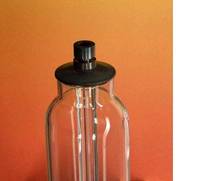
Note that most of the knowledge and examples given in this article are based on glass behavior in liquid water. In this article, we review the progress made in understanding silicate glass alteration mechanisms (second section), and then focus on the three aforementioned kinetic regimes (third section).

A high concentration of dissolved silica which reduces the affinity for matrix dissolution and the formation of a passivating alteration layer on the glass surface allows the establishment of stage II with low residual rates, while massive precipitation of secondary phases can trigger an acceleration of alteration (stage III). Stage I takes place in diluted and renewed solutions. This has led scientists to distinguish three main kinetic regimes depending on which mechanism or set of mechanisms control the alteration process: the initial dissolution rate regime (stage I), the residual alteration rate regime (stage II), and (for some glasses) a sudden potential acceleration of the alteration (stage III) (Fig. Calculation of a glass alteration rate can be further complicated by the fact that different mechanisms or different coupled mechanisms can control glass alteration during the reaction. The plethora of influencing parameters makes alteration difficult to predict from simple descriptors or parameters arising from structural analysis or tests performed in accelerated conditions. The alteration of silicate glasses is a complex phenomenon that depends both on the nature of the glass material, i.e., its chemical composition, structure (short and medium-range order), and bonding, and also on the environmental conditions, such as temperature, pH, Eh, and solution chemistry. The term ‘dissolution’ is employed when glass transforms into aqueous species only. The terms ‘alteration’ or ‘corrosion’ refer to the transformation of the glass into solid alteration products and aqueous species. Among others, these include the well-known categories of soda-lime glasses, borosilicate glasses, aluminosilicate glasses, etc. The term ‘silicate glass’ refers to any kind of vitreous materials in which SiO 2 is the most abundant oxide. Understanding their alteration mechanisms and rates is a preliminary step toward the understanding of different natural phenomena such as volcano slope stability 7, the chemical mass balance of the oceans 8, and the geological history of the planet Mars 9. Basaltic glasses are volcanic glasses found in different settings such as hyaloclastites and pillow-lavas, and in various locations, including submarine, subglacial, or lacustrine environments. Silicate glasses can also be produced naturally on Earth. For nuclear waste disposal, on the contrary, it is essential 6 to maintain waste glass long-term stability to prevent the release of radioactive elements into the biosphere for periods of thousands to hundreds of thousands of years. In particular, the reaction of a glass in aqueous environments and its alteration behavior is critical in applications such as biomedicine (e.g., bone repair) 4, where fast and controllable dissolution is preferred, or in agriculture to supply plants with nutrients 5. Among glass materials’ properties, chemical durability is important in many of the above-mentioned applications.
Ion bonding glass windows#
Silicate glasses are manmade materials with various applications in our daily life, ranging from tableware, labware, windows in construction, insulation, and reinforcement, to high technology fields such as optical lenses, displays, fibers, biomedicine, and nuclear waste disposal, all due to their ability to be customized 1, 2, 3. Mechanistic models have been developed at some specific scales, although holistic models still need further development to link the various scales and perform reliable predictions. Thanks to the development of novel techniques and international collaborations, a better understanding of the mechanisms involved has been achieved.

In this article, we review the current state of knowledge on glass alteration mechanisms and kinetics, and point to some perspectives for glasses for which no direct experimental validation is currently possible. Due to the wide diversity of the chemical composition for these types of materials and their metastability-no thermodynamic equilibrium can be reached between glass and solution-the evaluation of chemical durability remains a scientific challenge.

The question of silicate glass chemical durability is at the heart of many industrial and environmental issues, with certain glasses, such as bioglasses, needing to transform rapidly, while others, like nuclear glasses, extremely slowly.


 0 kommentar(er)
0 kommentar(er)
